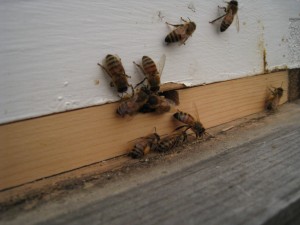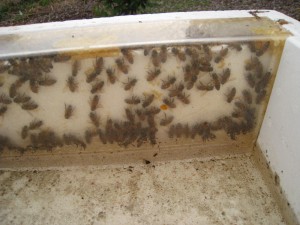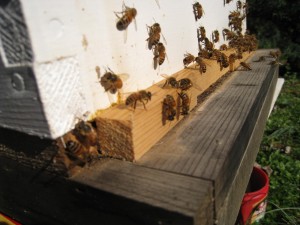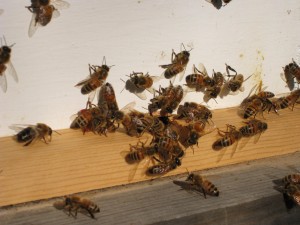A Warm Day Arrives in Central Virginia!
Beekeeping in the Winter is clearly going to be just like the Summer – I look at the bees and wonder what the heck they are doing, if they are struggling and, finally, is the mere act of me ‘messing’ with them setting them back further!?! All of these questions ran through my mind over the Summer and it’s deja vu all over again.
Regardless, Richmond, Va had a day of fairly good weather. They were calling for the mid-50’s, but the only time that I could check the gals was over my lunch break at 1 pm, when it was 58 degrees (that’s in Richmond, as my thermometer says 55 degrees.) Regardless, Tom Fifer always said that ‘if the bees are flying, you can check on them’ and my bees were definitely flying today.
Hive 2
The weak hive was alive with activity. As always, I wondered if I was looking at some of my bees coming out for a breather (lots of wet and cold weather these past few weeks) or if I was looking at a battle to the death between my bees and some neighboring hives (feral or maybe my own!) I could see no fighting and, of greatest interest, I could see a TON of the workers coming in with pollen packed to the gills! I am terrible with colors, but it looked like a pale yellow to me. Maybe some grass pollen? Even my camellias have stopped blooming, so I have no idea what could be blooming out there now. It must be left over grass pollen. There were a few (maybe 3) bees dead or dying beneath the hive, but I am guessing these are the old gals that are going to the great big bee hive in the sky. At one point there were 60+ bees either flying about in front of the hive or climbing around the small entrance hole. By the time I opened them up, it was much less (more like 15 bees, with most on the landing board.)
One of my main tasks today was to remove the top feeder and then, on the next warm day, put down some fondant. This is a new substance to me that I recently read about in one of my bee magazines. Bees apparently have a hard time dealing with syrup in the Winter months. I probably should have executed my plan, but (as will be noted when I upload my pics) the bees were all over the syrup. A ton of them were taking it in. I simply decided to let it alone. There was not much syrup left and I might check with Tom Fifer on his thoughts about feeding syrup through the Winter before I remove this feeder.
Looking into the hive, it was not terrible news, but these gals do not have enough food to make it through the Winter. I probably have 5 frames full of honey in the top Deep super. The other frames are really mostly empty (or not even fully drawn out.) When I took a few frames out, I could see that the cluster was up towards the front of the hive (which would be the South side) in the center. There were a bunch of them and it made me wonder if part of the cluster was in the top super. I recently was advised not to break the cluster, so I stopped there. Of course, this made me wonder why the heck I opened it at all (to remove only two frames.) I need to check with some of the experienced beekeepers to see what they look for in Central Virginia (which may have different strategies then the ones I have heard from others.)
Hive 1
Hive 1 had much less bees about the front and I could not find a one with pollen loaded. I stayed for awhile (the sheer number of pollen bearers coming in at Hive 2 made me want to believe Hive 1 was at least doing a bit of this gathering.) But, I could not find one bee going into the hive with any pollen. Not really sure what this means.
Upon opening Hive 1 (which has no feeder), I found bees all the way to the top. Most of their frames are full, so I am guessing they are moving some honey around and otherwise moving up into the top super. This is the one that I will have to watch for swarming (or maybe doing a break to get another hive.) I am reluctant to do anything that would set them back, as I expect to get a big load of honey (or at least my first jar of honey) from this hive. I decided not to mess with any of the frames on this hive.
Next month, I will go a bit deeper and get some pollen patties on top of the brood next to give them a bit of food for the coming Spring.




